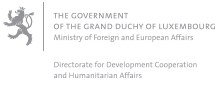- Home
- Preface
- Development Effectiveness
- World Humanitarian Summit
- I. Luxembourg’s official development assistance in 2016
- II. Cooperation with the main partner countries
- III. Regional cooperation and cooperation with other countries
- IV. Multilateral cooperation
- V. European Union
- VI. Cooperation with non-governmental development organisations
- VII. Humanitarian action
- VIII. Programme support
- IX. Development education and awareness raising
- X. Inclusive finance and the private sector
- XI. Evaluation
- XII. Report on the progress of the work of the Interministerial Committee for Development Cooperation in 2016
- Appendices
I. Luxembourg’s official development assistance in 2016

Transparency, a fundamental value of Luxembourg’s development cooperation
In subscribing to the Busan, Mexico and Nairobi Declarations, Luxembourg recognises the importance of aid transparency and predictability in improving development effectiveness.
Transparency may have many facets and may apply to a wide range of people. In particular, it enables:
- Governments and civil society of partner countries to manage their aid resources more effectively by integrating them into their budget forecasts and their national development plans. In this way, through the ICPs and framework agreements, the partners in the South have a multiannual financial programme for each sector and geographical area. Transparency and mutual responsibility are also strengthened via the dialogue that occurs at the annual partnership committee meetings with the partner countries.
- Luxembourg citizens and the Luxembourg parliament to understand how official development assistance is used and to see how it is contributing to poverty eradication and to achieving the Sustainable Development Goals. Thus, each year, development cooperation policy is the subject of a debate in the Chambre des deputés. Likewise, the Minister for Development Cooperation and Humanitarian Action regularly updates the Committee for Foreign and European Affairs, Defence, Development Cooperation and Immigration on the current areas of activity. Annual reports and strategic documents, such as the ICPs, overall and specific strategies, executive summaries of the evaluations, information brochures by country, etc. are publicly available on the Luxembourg’s development cooperation website.
- The technical and financial partners to coordinate their efforts better and to increase their efficiency through better distribution of their labour. The special partnership agreements signed with several multilateral agencies give them great predictability and flexibility.
Luxembourg also makes an annual notification to the OECD’s Development Assistance Committee (DAC) of the main ODA figures; the DAC, after verifying and approving these data, integrates them into the Creditor Reporting System (CRS), a database available online that enables targeted research and a host of analyses of ODA.
The availability and accessibility of the information on development assistance has been improved by an overhaul of the statistical categories on the Development Cooperation website, which now provides access to a host of statistical data. Real-time data is not yet available but the Ministry is working towards meeting the standard specified by the International Aid Transparency Initiative (IATI) in the coming years.
- An overview of official development assistance in 2016
- ODA in 2016 by Ministry
- Breakdown of ODA by type of cooperation in 2016
- Breakdown of ODA by intervention sectors in 2016
- The Development Cooperation Fund in 2016
- The change in official development assistance
- Transparency, a fundamental value of Luxembourg’s development cooperation

